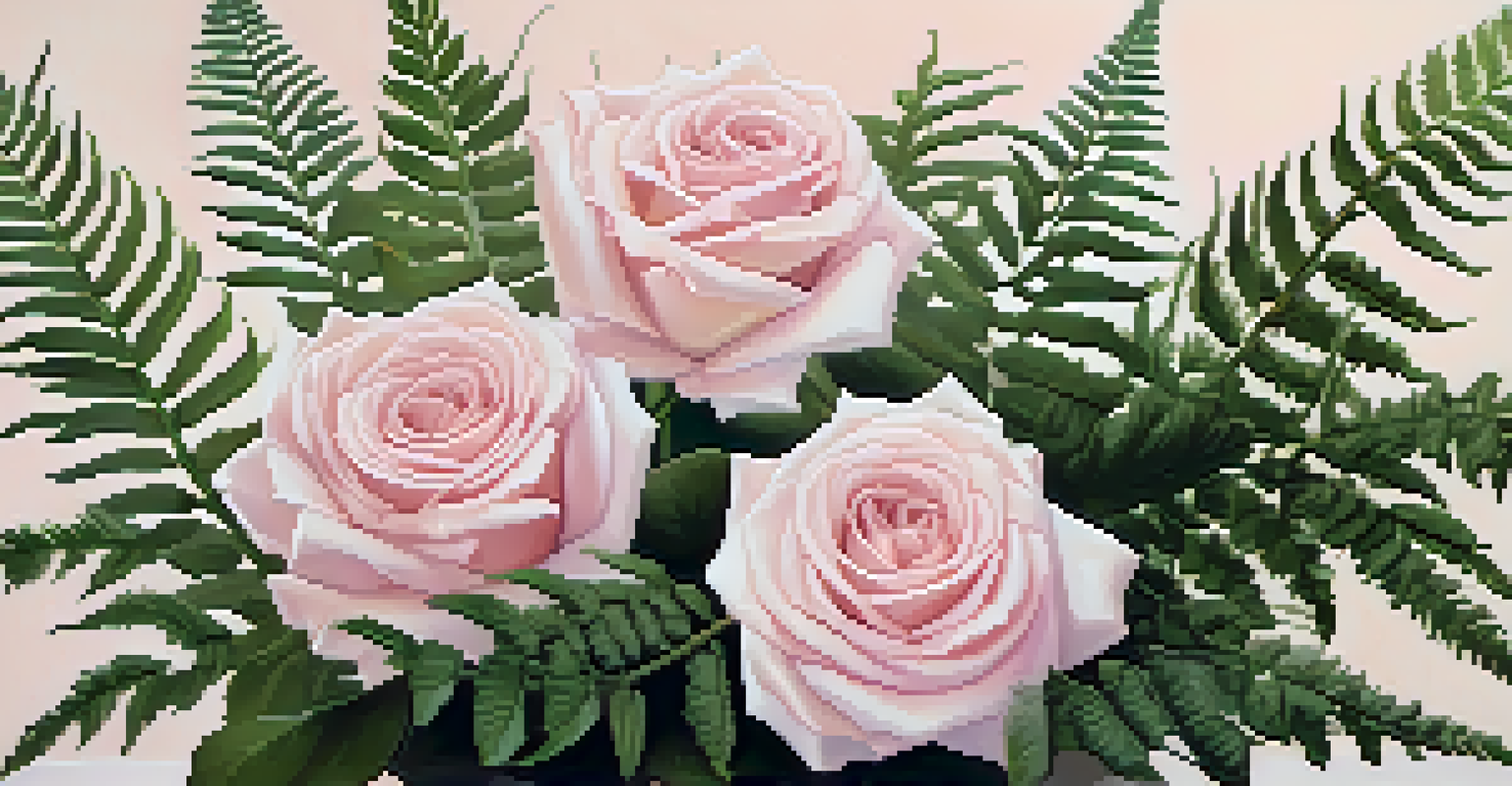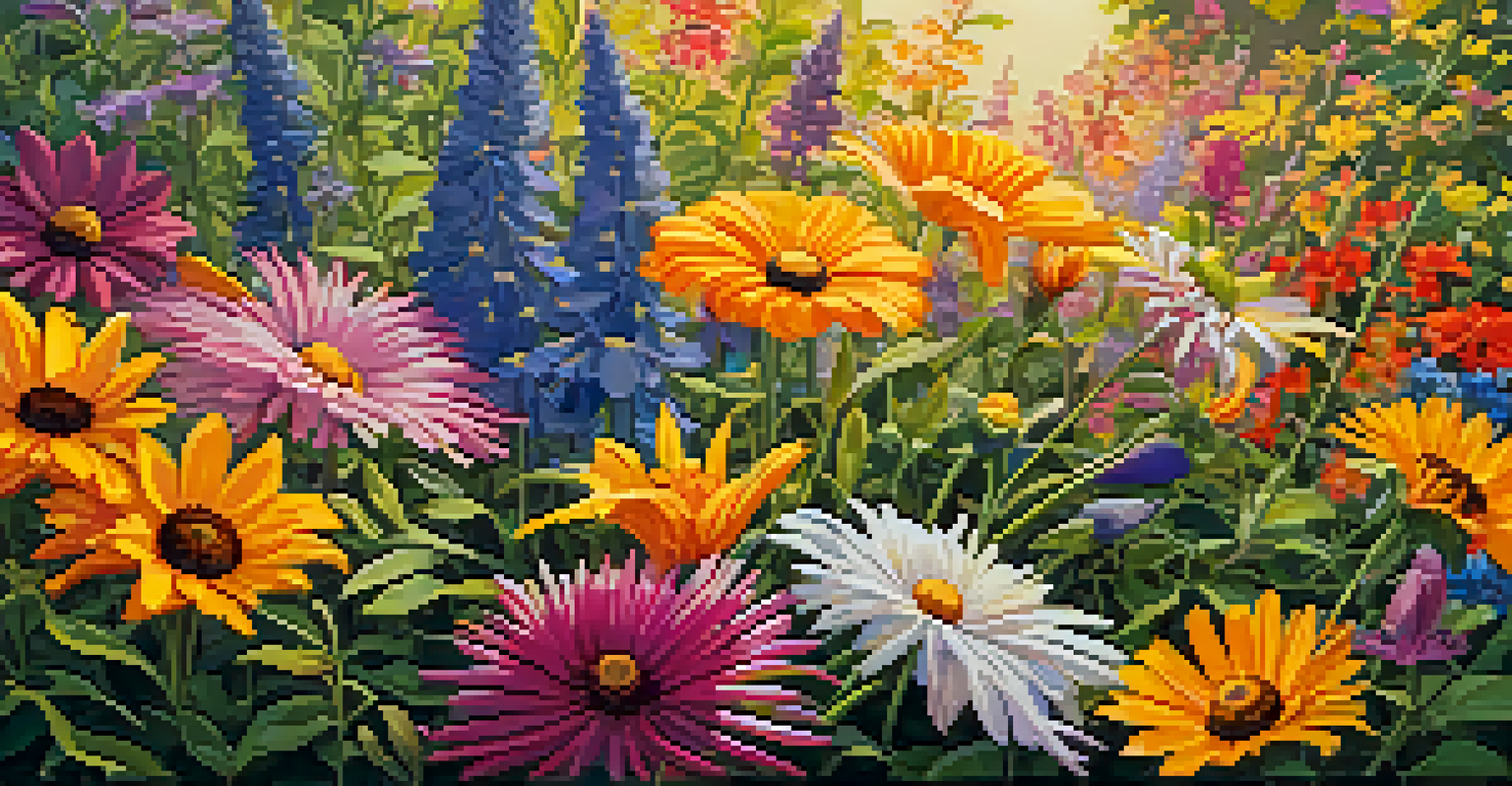Understanding Line in Floral Design: Creating Movement

What is Line in Floral Design and Why It Matters
In floral design, 'line' refers to the visual path that your eye follows when looking at a composition. It plays a crucial role in guiding the viewer's gaze and creating a sense of movement. Just like a painter uses lines to direct attention in their artwork, a floral designer employs line to enhance the overall aesthetic of their arrangement.
The beauty of the line is that it can create a rhythm that draws the viewer into the arrangement, making it a dance of colors and forms.
The importance of line lies in its ability to create structure and harmony within a bouquet. It helps define the shape and form of the arrangement, allowing each flower to interact beautifully with the others. Think of it as the backbone of your design—without it, the arrangement may feel disjointed or chaotic.
Lines can be straight, curved, or even zigzagged, each evoking a different emotion or atmosphere. For example, curved lines often convey softness and elegance, while straight lines can suggest formality and strength. Understanding how to use line effectively can elevate your floral designs to new heights.
Types of Lines in Floral Design: A Closer Look
In floral design, there are several types of lines that you can utilize to create movement: vertical, horizontal, diagonal, and curved. Vertical lines can create height and drama, drawing the eye upwards, which is perfect for towering arrangements like sunflowers or delphiniums. On the other hand, horizontal lines tend to evoke stability and calmness, making them ideal for low, spreading arrangements.

Diagonal lines add a dynamic touch, suggesting movement and energy, which can be great for vibrant designs meant to capture attention. Meanwhile, curved lines introduce a sense of flow and softness, often mimicking natural forms found in nature. Using a combination of these lines can create a balanced and visually appealing arrangement.
Line Guides Visual Movement
In floral design, line directs the viewer's gaze, creating a sense of movement and enhancing the overall composition.
By mixing these various types of lines, you can create a more complex and interesting floral design. Just as a musician combines different notes to create harmony, a floral designer can blend various types of lines to evoke specific feelings and guide the viewer's eye through the arrangement.
Creating Movement with Line in Floral Arrangements
Movement in floral design is all about how the arrangement draws the viewer's attention and leads the eye from one element to another. By strategically placing flowers and foliage along a line, you can create a sense of rhythm that guides the viewer through the entire composition. This is similar to how a well-choreographed dance captivates an audience.
Design is not just what it looks like and feels like. Design is how it works, and the line is central to its function.
To create movement, consider using a focal flower as an anchor point and then arranging supporting elements along a path or line that leads away from the focal point. This approach helps create a visual journey, making the arrangement more engaging. You might think of it like a winding road that invites exploration.
Additionally, varying the heights and orientations of your flowers can enhance the sense of movement. For example, using taller flowers at the back and shorter ones at the front can create a cascading effect that mimics natural growth. Such techniques make the arrangement feel alive and dynamic, inviting viewers to appreciate every detail.
Incorporating Line in Color and Texture Choices
While line is essential, it should be complemented by color and texture to create a cohesive design. Certain colors can enhance the perception of line; for instance, warm colors like reds and oranges can seem to advance, while cooler colors like blues and greens can recede. This interplay can help emphasize the lines you create within your arrangement.
Texture also plays a significant role in how line is perceived. Smooth, sleek flowers can create a clean, modern line, while rougher, more textured materials can add depth and complexity. Think of how the silky petals of a lily contrast with the rugged leaves of a fern; together, they can create a stunning visual narrative.
Types of Lines Create Emotion
Different types of lines—vertical, horizontal, diagonal, and curved—evoke varying emotions and can transform the feel of an arrangement.
By thoughtfully selecting colors and textures that enhance your lines, you can create an arrangement that is not only visually striking but also emotionally resonant. It’s like dressing a character in a story—every choice adds to the overall narrative you want to tell.
Balance and Proportion: The Role of Line
Balance and proportion are fundamental principles in floral design that closely relate to line. When creating an arrangement, it's essential to ensure that no single element overwhelms the others. By using line to distribute visual weight evenly, you can achieve a harmonious composition that feels stable and pleasing.
For example, if you have a tall flower on one side, consider balancing it with a cluster of shorter flowers on the opposite side. This creates a sense of equilibrium, making the arrangement feel well-structured. Just as you wouldn’t want one side of a seesaw to be too heavy, your floral design should strive for a similar balance.
Proportion is also about the relationship between different elements within the arrangement. Using line to guide the size and spacing of flowers can help maintain proportion, ensuring that each element complements the others. This attention to detail can make the difference between a mediocre arrangement and a stunning masterpiece.
Visual Flow: Guiding the Eye with Line
Visual flow is the concept of leading the viewer's eye through the arrangement in a deliberate way. By using lines effectively, you can create pathways that guide attention and enhance the viewer's experience. Think of it as a scenic route that invites exploration rather than a straight highway that rushes you to the destination.
To achieve visual flow, consider the placement of your flowers and how they relate to one another. Grouping similar elements together can create a rhythm that encourages the eye to travel smoothly from one cluster to the next. This technique is particularly effective when working with contrasting colors or textures to draw attention.
Balance and Proportion Matter
Using line effectively helps achieve balance and proportion in floral arrangements, ensuring no element overwhelms another.
It’s also helpful to create focal points along the flow line, such as a striking flower or unique foliage. These elements act like landmarks, giving the viewer’s eye a reason to move along the path you've created. By consciously designing for visual flow, you can make your floral arrangements more engaging and enjoyable to behold.
Practical Tips for Mastering Line in Floral Design
Now that you understand the importance of line in floral design, here are some practical tips to help you master it. First, always start with a clear idea of the arrangement's shape and flow before placing your flowers. Sketching out your design can serve as a helpful roadmap, guiding you as you work.
Experiment with different line types by using a variety of flowers and foliage. Don’t be afraid to mix tall and short, smooth and textured. This experimentation can lead to unexpected and beautiful results, much like an artist trying out different brush strokes to capture a scene.

Finally, step back often to assess your work from a distance. This perspective allows you to see how well the lines are working together and whether they create the desired movement. Remember, floral design is both an art and a science, and finding the balance between the two will lead to stunning outcomes.